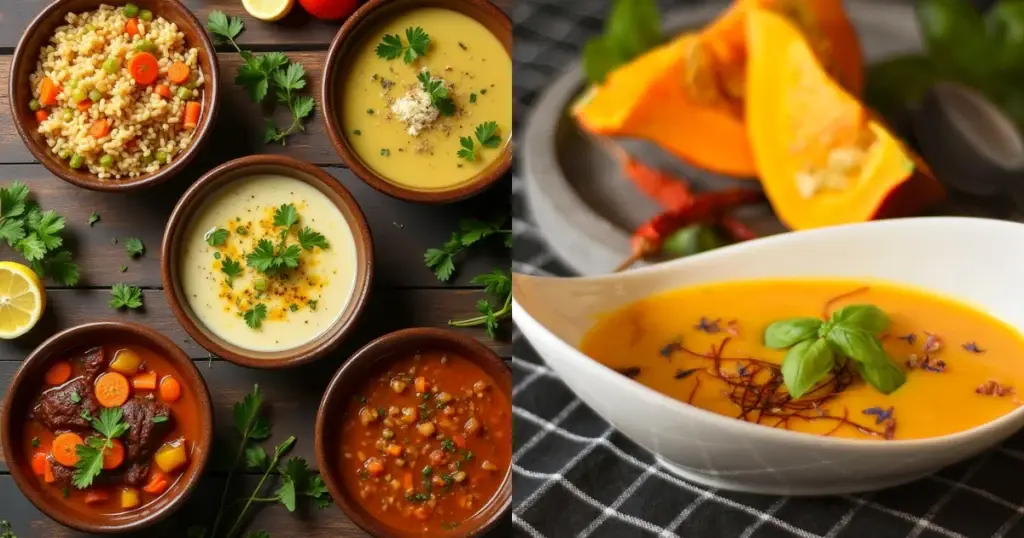The Ultimate Guide to Gluten-Free Soup: Wholesome Comfort for Every Diet
Table of Contents
Gluten-Free Soup Recipes for a Cozy Meal
Are you craving a warm, comforting bowl of soup but need to avoid gluten? You’re not alone. Gluten-free soup options have expanded dramatically in recent years, making it easier than ever to enjoy this classic comfort food without worry. In this comprehensive guide, we’ll explore everything you need to know about creating delicious gluten-free soups that satisfy both your taste buds and dietary needs.
What Exactly Is Gluten-Free Soup?
Gluten-free soup is exactly what it sounds like—soup that doesn’t contain gluten, a group of proteins found in wheat, barley, and rye. For people with celiac disease, non-celiac gluten sensitivity, or wheat allergies, consuming gluten can trigger serious health issues, from digestive problems to long-term intestinal damage.
Traditional soups often contain hidden gluten in ingredients like:
- Thickeners made from wheat flour
- Pasta or noodles
- Barley (common in beef and vegetable soups)
- Soy sauce or other flavoring agents that may contain wheat
The good news? Creating gluten-free versions of almost any soup is entirely possible—and often just as delicious as the original!
Benefits of Gluten–Free Soup
Beyond being a necessity for those with gluten-related disorders, gluten-free soups offer several advantages:
Health Benefits
- Improved Digestion: Even for those without celiac disease, gluten–free soups can be gentler on the digestive system.
- Weight Management: Focusing on vegetable-based soups naturally increases nutrient intake while potentially reducing calorie consumption.
- Reduced Inflammation: Many people report decreased inflammation when eliminating gluten, particularly those with autoimmune conditions.
- Diverse Nutrients: Gluten-free soups often incorporate a wider variety of grains and vegetables, broadening your nutritional profile.
Lifestyle Benefits
- Family-Friendly Options: Gluten free soups can be enjoyed by everyone, making meal planning easier for mixed-diet households.
- Batch Cooking: Most gluten–free soups freeze beautifully, making them perfect for meal prep.
- Customizable: Easy to adapt to other dietary needs like dairy-free or vegetarian requirements.
Essential Gluten Free Soup Ingredients Guide
Creating delicious gluten free soups starts with understanding which ingredients are safe and which need substitution.
Gluten-Free Soup Bases
- Homemade Stock: The safest option—make your own using bones, vegetables, herbs, and water.
- Store-Bought Broths: Look for certified gluten-free options. Many major brands now offer them.
- Bouillon Cubes/Powder: Be extremely cautious with these—many contain gluten as a binder or flavoring agent.
Safe Proteins
- Fresh Meats: Chicken, beef, pork, and fish in their natural state are gluten free.
- Beans & Legumes: Dried or canned beans are excellent gluten free protein sources (rinse canned varieties thoroughly).
- Tofu: Plain, unflavored tofu is generally gluten free and works well in Asian-inspired soups.
Vegetables & Fruits
- All Fresh Produce: Vegetables and fruits in their natural state are gluten free and soup-friendly.
- Frozen Vegetables: Most plain frozen vegetables are safe, but check labels on seasoned varieties.
- Canned Vegetables: Generally safe, but always verify no gluten-containing additives are included.
Gluten-Free Thickeners
- Rice Flour: Creates a smooth texture similar to wheat flour.
- Cornstarch: Provides excellent thickening with a transparent finish.
- Potato Starch: Works well for creamy soups.
- Arrowroot Powder: Natural thickener that works especially well in acidic soups.
- Pureed Vegetables: Blend portion of your soup vegetables for natural thickening.
Herbs, Spices & Flavorings
- Fresh/Dried Herbs: Natural herbs are gluten-free.
- Pure Spices: Single-ingredient spices are safe; be cautious with blends.
- Gluten-Free Tamari: Replaces soy sauce in Asian-inspired soups.
- Apple Cider Vinegar: Adds brightness to many soups.
- Coconut Aminos: Excellent gluten-free alternative to soy sauce.
Ingredients to Avoid
- Barley: Common in “beef & barley” soups and some broths.
- Wheat Pasta/Noodles: Use gluten-free alternatives instead.
- Flour Roux: Traditional thickening method that contains gluten.
- Soy Sauce: Contains wheat (unless labeled gluten-free).
- Some Broths/Stocks: May contain gluten as flavoring agents.
- Malt Vinegar: Contains barley.
Common Mistakes to Avoid When Making Gluten_Free Soup
Even with the best intentions, gluten can sneak into your soup. Here are key pitfalls to avoid:
Cross-Contamination Issues
- Shared Cutting Boards: Use separate cutting boards for gluten-free food prep.
- Utensils: Avoid wooden utensils previously used with gluten products.
- Toasters: Breadcrumbs are common contaminants when making soup accompaniments.
- Colanders/Strainers: If previously used for pasta, these can harbor gluten residue.
Hidden Gluten Sources
- Pre-made Spice Blends: May contain gluten as an anti-caking agent.
- Imitation Crab/Seafood: Often contains wheat as a binder.
- Canned Soups: Most conventional canned soups contain gluten.
- Bouillon Cubes: Frequently contain wheat derivatives.
Recipe Execution Errors
- Not Reading Labels: Ingredients change; always verify products remain gluten-free.
- Assuming All Grains Are Off-Limits: Rice, quinoa, and certified gluten-free oats can add wonderful texture.
- Overcooking Gluten-Free Additions: Gluten-free noodles often cook faster than traditional pasta.
Top Gluten_Free Soup Recipes
Here are some delicious gluten-free soup recipes to get you started:

1. Classic Chicken and Rice Soup
A comforting favorite made gluten-free with rice instead of noodles. The combination of tender chicken, aromatic vegetables, and hearty rice creates a satisfying meal that’s easy on the stomach.
2. Creamy Potato Leek Soup
Naturally gluten-free when thickened with pureed potatoes instead of flour. The mild onion flavor of leeks pairs perfectly with creamy potatoes for a smooth, sophisticated soup.
3. Hearty Beef and Vegetable Stew
Skip the flour dredge and thicken naturally with pureed vegetables for a robust, satisfying stew. Rich in protein and vegetables, this filling soup is perfect for colder months.
4. Thai-Inspired Coconut Curry Soup
Coconut milk provides natural creaminess while curry paste adds depth of flavor—all gluten-free! This soup delivers a harmonious blend of sweet, zesty, and umami flavors.
5. Mediterranean Lentil Soup
Protein-packed lentils create a filling soup that’s naturally gluten-free and budget-friendly. Brightened with lemon and herbs, this soup is both nutritious and delicious.
Buying Guide: Store-Bought Gluten_Free Soups
When you don’t have time to cook from scratch, these pre-made options can save the day:
Trusted Brands
- Pacific Foods: Offers clearly labeled gluten-free soups.
- Amy’s Kitchen: Many certified gluten-free options.
- Imagine Foods: Extensive range of gluten-free broths and soups.
- Progresso: Has a growing gluten-free soup line.
What to Look For
- Certification Labels: Look for official gluten-free certification symbols.
- Ingredient Lists: Even if labeled “gluten-free,” always verify ingredients.
- Cross-Contamination Statements: Some products may be naturally gluten-free but processed in facilities with gluten.
Price Considerations
Store-bought gluten-free soups typically cost 20-50% more than conventional options. Stock up when on sale, or focus on making your own for significant savings.
Frequently Asked Questions About Gluten_Free Soup
Is canned soup gluten-free?
Most mainstream canned soups are NOT gluten-free, as they often contain wheat flour as a thickener or noodles/barley as ingredients. However, specialty brands like Amy’s, Pacific Foods, and others offer certified gluten-free options.
Can I use cornstarch as a thickener?
Yes! Cornstarch is an excellent gluten-free thickener. Mix 1 tablespoon with 2 tablespoons of cold water before adding to hot soup to prevent clumping. It provides a smooth, transparent finish.
Are bouillon cubes gluten-free?
Most traditional bouillon cubes contain gluten. Look specifically for certified gluten-free versions or make your own concentrated stock.
How can I add more flavor to my gluten–free soup?
Boost flavor with gluten-free options like:
- Fresh herbs added at the end of cooking
- Smoked paprika or other single-ingredient spices
- Gluten-free tamari or coconut aminos
- A dash of vinegar or lemon juice to enhance and elevate the flavors.
- Nutritional yeast for a savory, cheese-like flavor
Can I freeze gluten-free soup?
Absolutely! Most gluten-free soups freeze beautifully. Portion into individual containers, leaving room for expansion, and freeze for up to 3 months. Thaw overnight in the refrigerator for best results.
Conclusion
Gluten-free soup isn’t just a dietary necessity—it’s an opportunity to explore new flavors and ingredients while enjoying one of life’s most comforting foods. With the right knowledge about ingredients, preparation techniques, and flavor combinations, you can create delicious soups that everyone will enjoy, regardless of dietary restrictions.
Whether you’re new to gluten-free cooking or a seasoned pro looking for fresh ideas, incorporating these easy gluten-free soup recipes into your meal rotation provides nourishing, satisfying options for every season. From hearty stews to light broths, the best gluten-free soup recipes often become family favorites that transcend dietary labels.
What’s your favorite gluten_free soup? We’d love to hear about your creations in the comments below!







